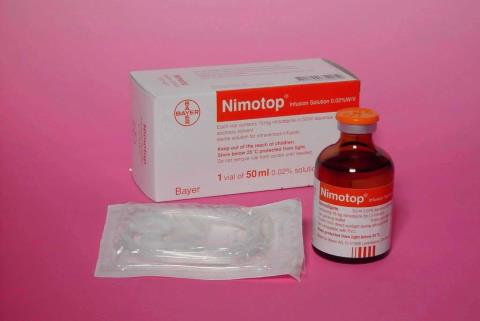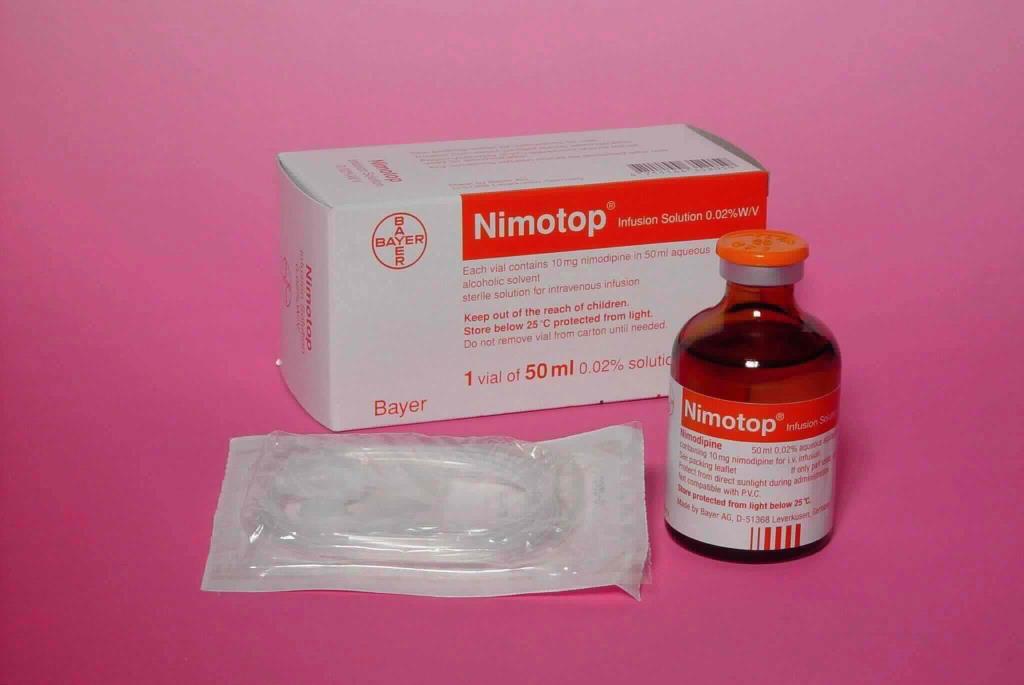What you need to know about Nimotop (nimodipine)

What is Nimotop (nimodipine)? How to use the drug to achieve the effect? What should be kept in mind when taking the drug? Let's analyze the article with SignsSymptomsList below to understand more about Nimotop (nimodipine)!
Active ingredients: nimodipine
Similar ingredient names : Celenal; Daehanmodifin inj.; Eftipine; HTP-Encemin; Inimod; Mianifax; Nidopine; Nimodi; Nimotop; Nimotop IV; Nimovac-V,..
content
- 1. What is Nimotop (nimodipine)?
- 2. In case Nimotop (nimodipine) should not be used.
- 3. Instructions for taking Nimotop (nimodipine)
- 4. Nimotop (nimodipine) side effects
- 5. Drug interactions when taking Nimotop (nimodipine)
- 6. Note when using Nimotop (nimodipine)
- 7. For pregnant and lactating women when taking Nimotop (nimodipine)
- 8. Treatment of overdose Nimotop
- 9. How to store medicine
1. What is Nimotop (nimodipine)?
Nimotop contains the active ingredient nimodipine. This drug belongs to the group of calcium channel blockers, which helps to dilate blood vessels and improve blood circulation.
The drug is available in dosage forms: intravenous and oral. The drug is indicated for the prevention and treatment of cases of vasospasm causing neurological ischemia after subarachnoid hemorrhage due to rupture of an intracranial aneurysm.
2. In case Nimotop (nimodipine) should not be used.

- Allergy to nimodipine or any of the other ingredients.
- Within 1 month since the patient had a myocardial infarction, unstable angina, and acute porphyria, the drug should not be used.
3. Instructions for taking Nimotop (nimodipine)
3.1. How to use
- Chew the medicine with a little water.
- Because bioavailability of the drug is reduced when taken with food, it is recommended to take the drug 1 hour before or 2 hours after eating.
3.2. Dosage
- Preventive
You take a dose of 60 mg / time, each dose is 4 hours apart (4 hours / time). Initiate therapy within 4 days of subarachnoid hemorrhage and continue for 21 days. For patients with liver failure, the dose is 30 mg/time, every 4 hours.
- Treatment
Subarachnoid hemorrhage: When the patient has been diagnosed with a subarachnoid hemorrhage (with neurological deficit), the drug will be administered intravenously through a catheter into the central vein. Initiate treatment with a dose: infused at a rate of 1 mg/hour over 2 hours. The dose will then be increased to 2 mg/hour (provided that blood pressure does not decrease significantly).
Unstable blood pressure: In case for a patient weighing <70 kg,="" in="" person="" yes="" blood="" blood pressure="" no="" ok=" " determine,="" or="" in="" person="" yes="" function="" capacity="" liver="" reduce="" then="" dose="" initialize="" first="" need="" must="" decrease="" dose="" ≤0.5="" mg/="" hour.="" continue="" continue="" injection="" infusion ="" in="" least="" at least="" 5="" days="" and="" 14="">
It should be noted that the implementation of treatment must begin as soon as possible.
4. Nimotop (nimodipine) side effects

- Constipation
- Thrombocytopenia
- Increase liver enzymes
- Headache, Dizziness
- Extrasystoles, sweating
- Nausea, diarrhea, bloating
- Thrombophlebitis, rash
- Facial flushing, bowel obstruction (rare)
- Increased serum creatinine and blood nitrogen
- Lower blood pressure, bradycardia, tachycardia
5. Drug interactions when taking Nimotop (nimodipine)
- Magnesium salts, amifostin, phenytoin, tacrolimus, rituximab.
- Calcium channel blockers: Because the cardiovascular effects of these drugs are enhanced by the addition of nimodipine.
- Cimetidine: care should be taken when calculating the dose for a patient.
- Ranitidine and Famotidine: No significant effect on drug metabolism.
- Alpha1 blockers, azole antifungals, calcium channel blockers, cyclosporin, macrolide antibiotics, MAOIs, grapefruit juice: increase the effect of the drug.
- Rifampicin, phenobarbital, carbamazepine and valproic acid: decreased effect of nimodipine).
6. Note when using Nimotop (nimodipine)
- Use with extreme caution in cases of cerebral edema and increased intracranial pressure.
- Nimodipine has effects similar to those of calcium channel blockers, such as blood pressure regulation, but is less pronounced.
- Patients with liver disease will reduce the metabolism of nimodipine due to impaired liver function.
- Caution when used concurrently with other antihypertensive drugs.
- Some points to watch out for in the elderly because they can be prone to constipation and low blood pressure.
There is no evidence yet on the safety and effectiveness of the drug in children.
7. For pregnant and lactating women when taking Nimotop (nimodipine)
7.1. Pregnant women
Nimodipine can cause premature loss of uterine contractions. However, this effect has not been shown to affect delivery. In cases of maternal hypotension due to decreased peripheral blood vessels, there is a risk of hypoxia of the fetal tissues.
7.2. Breastfeeding Women
Studies have shown that nimodipine and/or its metabolites are excreted in the milk of female rats at much higher concentrations than in maternal plasma.
However, it is not known whether the drug is excreted in human milk. Therefore, the mother should also not breast-feed while taking nimodipine.
8. Treatment of overdose Nimotop
There have been no reports of overdose due to oral nimodipine. Overdose symptoms may include excessive peripheral vasodilation with marked systemic hypotension. In case of hypotension due to overdosage of nimodipine, intensive cardiovascular support therapy may be required. In which, norepinephrine or dopamine can be used to restore blood pressure.
Note that dialysis should not be used to remove nimodipine because nimodipine is highly protein bound. Therefore, dialysis is ineffective.
9. How to store medicine
- Keep medicine out of reach of children and young children
- Store capsules protected from light and do not freeze
- Store nimodipine capsules and tablets at 15 – 30 °C
- Do not use expired medicine. The expiry date of the medicine is indicated on the packaging
Nimotop is a brand-name drug containing the active ingredient nimodipine, a calcium channel blocker used to prevent or treat ischemic constriction of blood vessels. The drug can cause side effects such as headache, dizziness, ..Patients should monitor their own condition carefully, if there is anything abnormal, call the doctor immediately for prompt emergency care.
Pharmacist Nguyen Ngoc Cam Tien